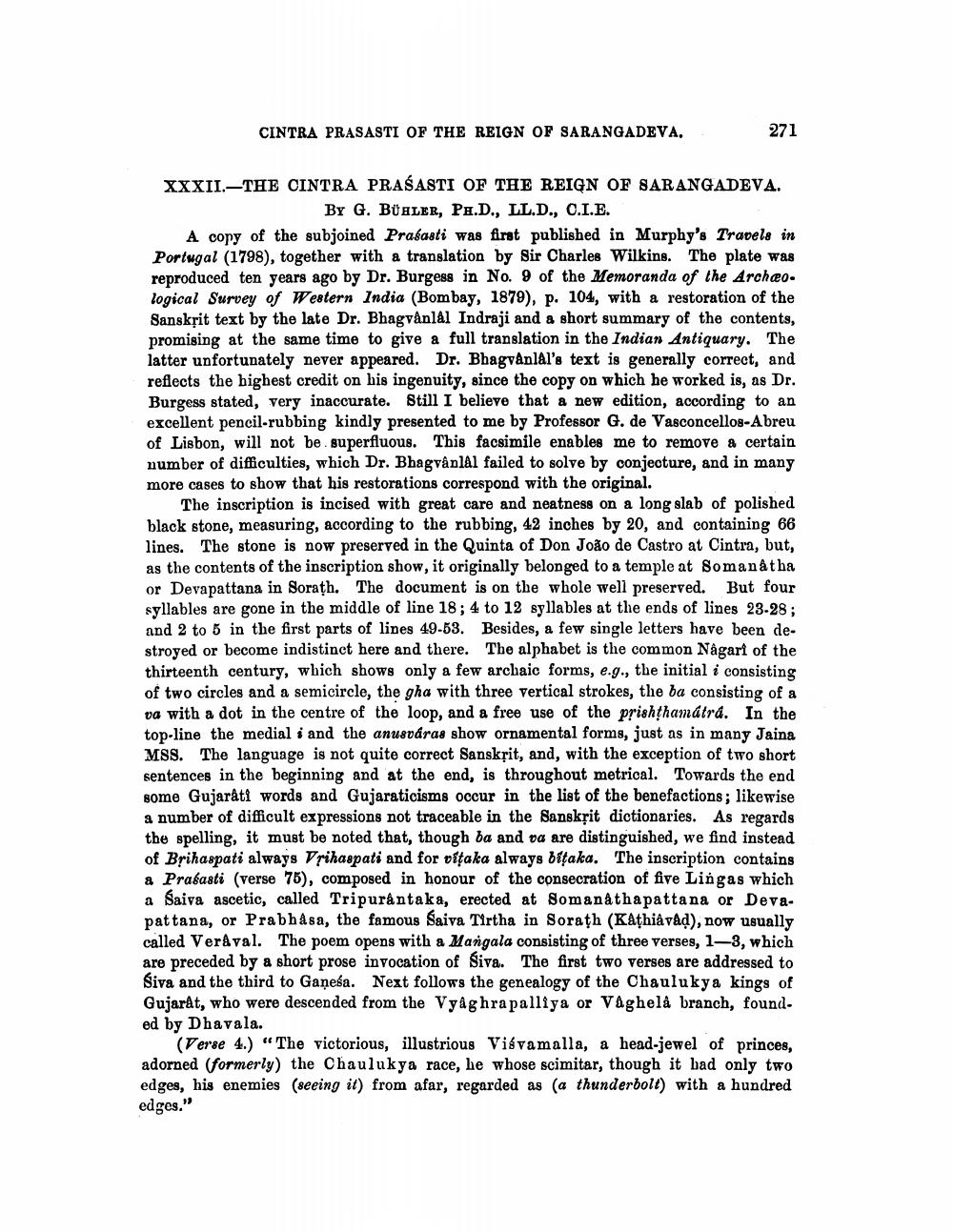________________
CINTRA PRASASTI OF THE REIGN OF SARANGADEVA.
271
XXXII. THE CINTRA PRASASTI OF THE REIGN OF SARANGADEVA. BY G. BÜHLER, PH.D., LL.D., C.I.E.
A copy of the subjoined Prasasti was first published in Murphy's Travels in Portugal (1798), together with a translation by Sir Charles Wilkins. The plate was reproduced ten years ago by Dr. Burgess in No. 9 of the Memoranda of the Archeological Survey of Western India (Bombay, 1879), p. 104, with a restoration of the Sanskrit text by the late Dr. Bhagvânlâl Indraji and a short summary of the contents, promising at the same time to give a full translation in the Indian Antiquary. The latter unfortunately never appeared. Dr. Bhagvanlal's text is generally correct, and reflects the highest credit on his ingenuity, since the copy on which he worked is, as Dr. Burgess stated, very inaccurate. Still I believe that a new edition, according to an excellent pencil-rubbing kindly presented to me by Professor G. de Vasconcellos-Abreu of Lisbon, will not be superfluous. This facsimile enables me to remove a certain number of difficulties, which Dr. Bhagvânlâl failed to solve by conjecture, and in many more cases to show that his restorations correspond with the original.
The inscription is incised with great care and neatness on a long slab of polished black stone, measuring, according to the rubbing, 42 inches by 20, and containing 66 lines. The stone is now preserved in the Quinta of Don João de Castro at Cintra, but, as the contents of the inscription show, it originally belonged to a temple at Somanâtha or Devapattana in Sorath. The document is on the whole well preserved. But four syllables are gone in the middle of line 18; 4 to 12 syllables at the ends of lines 23-28; and 2 to 5 in the first parts of lines 49-53. Besides, a few single letters have been destroyed or become indistinct here and there. The alphabet is the common Nagarî of the thirteenth century, which shows only a few archaic forms, e.g., the initial i consisting of two circles and a semicircle, the gha with three vertical strokes, the ba consisting of a va with a dot in the centre of the loop, and a free use of the prishṭhamátrá. In the top-line the medial i and the anusváras show ornamental forms, just as in many Jaina MSS. The language is not quite correct Sanskrit, and, with the exception of two short sentences in the beginning and at the end, is throughout metrical. Towards the end some Gujarati words and Gujaraticisms occur in the list of the benefactions; likewise a number of difficult expressions not traceable in the Sanskrit dictionaries. As regards the spelling, it must be noted that, though ba and va are distinguished, we find instead of Brihaspati always Frihaspati and for offaka always bifaka. The inscription contains a Prasasti (verse 75), composed in honour of the consecration of five Lingas which a Saiva ascetic, called Tripurantaka, erected at Somanathapattana or Devapattana, or Prabhasa, the famous Saiva Tirtha in Sorath (Kathiâvâḍ), now usually called Verâval. The poem opens with a Mangala consisting of three verses, 1-3, which are preceded by a short prose invocation of Siva. The first two verses are addressed to Siva and the third to Ganesa. Next follows the genealogy of the Chaulukya kings of Gujarat, who were descended from the Vyaghrapalliya or Vaghela branch, founded by Dhavala.
(Verse 4.) "The victorious, illustrious Viévamalla, a head-jewel of princes, adorned (formerly) the Chaulukya race, he whose scimitar, though it had only two edges, his enemies (seeing it) from afar, regarded as (a thunderbolt) with a hundred edges."




